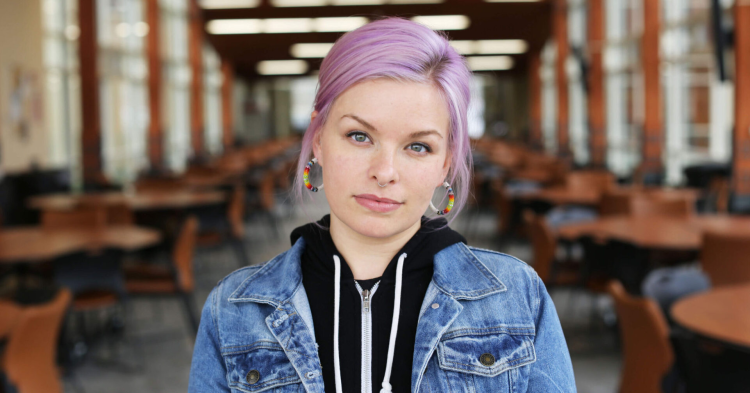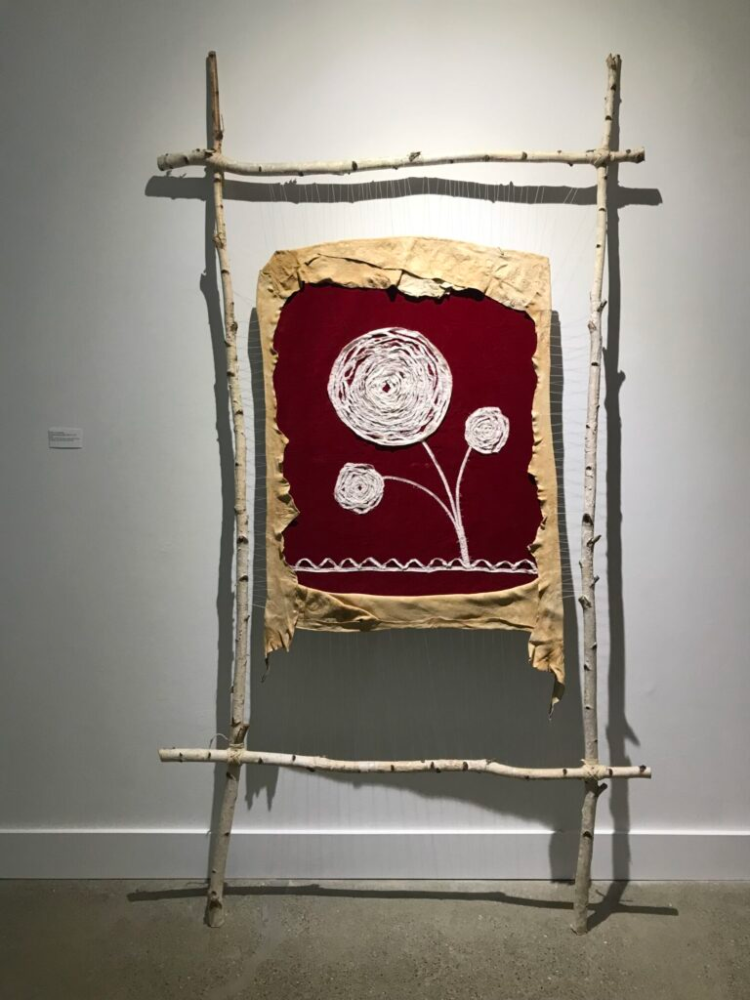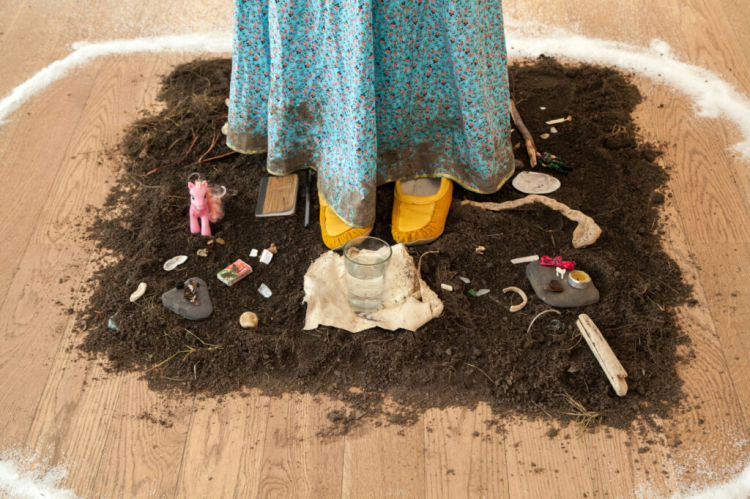Western's visual arts department recently welcomed Jodi Lynn Maracle as the 2025-26 Indigenous artist-in-residence.

Jodi Lynn Maracle, Indigenous artist-in-residence for 2025-26, uses deer hide tanning in her art practice and teaches it as an important cultural practice for Haudenosaunee people. (Caleb G. Abrams)
Maracle is a mixed Tyendinaga Mohawk/settler artist, born and raised in what is currently considered Buffalo, NY., who now lives in Brantford, Ont. She is also a doula, actor, parent and Kanien'kéha language teacher and learner.

Jodi Lynn Maracle's piece, called Caroline Parker Didn't Ask for This' is made from home-tanned deer hide that Maracle smoked. (Submitted)
Her work has been shown throughout Dish With One Spoon Territory in site specific installation performances such as the Mush Hole Project at the defunct Mohawk Institute Residential School (home of the Woodland Cultural Centre), the Gardiner Museum in Toronto and the Burchfield-Penney Art Center in Buffalo, NY. Her art is also part of the permanent collections at the Seneca-Iroquois National Museum in Ohi:yo', the University at Buffalo's Anderson Gallery and the Buffalo AKG Art Museum.
Maracle's most recent work centers on hide tanning, using traditional materials, methods and medicines.
During her residency, Maracle has access to studio space, equipment and other resources to create a new artistic work, which will be exhibited at Western in May 2026. She is also teaching a hands-on studio course in the winter term, entitled Haudenosaunee Material Culture in Practice: Relationship to Place, Making as Medicine and Responsibility to the Land.
Western News spoke with Maracle to learn more about her experience as an artist and the Haudenosaunee philosophies shaping her life and work.
What originally drew you to the arts?
Jodi Lynn Maracle: I've been making things for as long as I have had a memory.
There's a picture of my first big project from when I was three. I cut up my mom's pillowcase and stapled it to make a bikini to put on a fashion show.
I feel fortunate to have grown up with so many relatives who weren't artists per se but were always very DIY and motivated by an idea, whether they were crocheting, building things or fixing cars. I think that's what planted the seed of possibility of pursuing the arts.
When did you start hide tanning?
JLM: About 10 years ago, I attended a tanning workshop series taught by Rosary Spence, a Mushkegowuk (Swampy Cree) designer and visual artist (from Fort Albany First Nation). I remember after the first session, I was locked in. It just felt right.
I had no money at the time, so I made my own tools, and I would bake for my hunter friends, trading for hides.
My personal practice kept growing from there. I began teaching workshops and was being increasingly asked to facilitate full hide camps.
Tell me more about the hide camps and why you offer them.
JLM: As much as I use hide tanning in my art practice, it's also an important cultural practice for us as Haudenosaunee people to reclaim identity, reclaim responsibilities and connect with creation. There are a few families across all our territories who passed it on intergenerationally, but it hasn't been a community practice in more than 100 years.
What's interesting to me is that in the 1850s, there were anthropologists reporting on our material culture, and recording the process of hide tanning. But by the early 1900s, they couldn't find any Haudenosaunee hide-tanners. It's not that people don't want to learn, it's a result of things like massive land dispossession and widespread death.
Traditionally tanned buckskin from deer was not just used for our clothes and moccasins, it is also used in certain ceremonies.

Jodi Lynn Maracle's sculpture and performance installation, What do you carry? What do you leave behind?' with soil, calico, deer hide, salt, found objects at the Gardiner Museum, August 2018; part of Blood Soaked Soil. (Submitted)
I know from friends in other communities that, for many Indigenous nations, hide tanning is referred to as a grief practice. You're transforming death into life.
We have so many incredible artists and makers who want to use brain tanned hides, and we have so many hunters in our communities. For me, it's about closing that gap.
What materials do you use in the process of hide tanning?
JLM: In our practice, whether it's hide tanning, corn husking or our medicines, all the materials can be found within Dish With One Spoon territory. Tanning is place specific. We use the white-tailed deer, ancestral hardwood ashes from the trees around us and burn our corn cobs to smoke the hides.
We're also careful to save as much of the animal as we can because there's a relationship of reciprocity.
We use the deer's brain, which is pure fat, and rainwater to soften the fibers in the hide. You can use other things to make solutions if you don't have brains, but every mammal has enough of its own brain to tan its hide, except for humans and bison.
Sound is an important part of your installations. How does it relate to your work?
JLM: I like to listen to the music of the deer hides. There's a rhythm to the scraping, there's a rhythm to the softening, the fleshing and when you're swishing and soaking it.
Besides being an artist and hide tanner, you are a Kanien'kéha language teacher. Did you grow up with your language, or did you have to go learn it?
JLM: My grandfather was a first language speaker and the last of our dialect when he died in 2023. So, I knew a couple of phrases and a few words, but I ended up taking an adult immersion program in Buffalo.
"I now teach the language online and can run hide camps entirely in the language. I'm raising my kids in the language and in their ceremonies, reimagining a new future." - Jodi Lynn Maracle, Indigenous artist-in-residenc 2025-26
What do you hope to create for your art installation at Western?
JLM: I want to explore and see what the hides can do as a sculptural material and think about the stories behind them.
I've experienced some unexpected losses this past year and it feels important to use the support and the studio space at Western to explore the messier things.
I'm very much someone who likes to play and discover. Part of the relationship to the deer hide is, even when you're tanning it, you can think it's going to do one thing, and it will do something else. It's dead, but it still has a life to it.
What do you wish more people knew about hide tanning?
JLM: I think when people think about hide tanning or hunting, they tend to think of a wilderness mountain man doing it on his own. But it's a community practice.
We would have needed hundreds and thousands of hides just to clothe the village. Even today, not counting a four-day soaking process, it can take anywhere from four to seven days to do one hide.
You work in relationship with the hunters. I have training sessions for them too, so they know how to skin the deer and how to remove the brains. But I'm also trying to build capacity to get people working together and supporting each other.
My overall goal in teaching hide tanning is to be obsolete in eight years, because there will be so many people doing it.
Responses edited for brevity and clarity.










